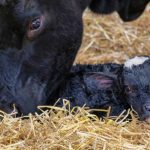
The Dairy Corner

Accelerate milk replacer programs for higher heifer gains
Dairy Corner: Milk replacer is expensive, but feeding more still makes sense to grow larger, healthier heifers

The five-minute tricks to identify good dry matter intake in dairy cows
Dairy Corner: Checking the condition of cows, and a quick look at the ration, can tell the story

Well-balanced starch and forage levels make milk
Dairy Corner: The amount of starch in corn and barley silage can vary greatly between harvests

Watch dairy heifers grow on well-balanced diets
The Dairy Corner: There are numerous ways to get a quality mix to a farm’s heifers

Dear Dairy Diary: SARA in lactating dairy cows
Dairy Corner: Changing the effective forage fibre resulted in subtle but important improvements

How field peas fit in dairy lactation diets
Dairy Corner: Research and some practical trials show peas can be fed to cows with no effect on milk yield

Strategic use of chelated minerals makes financial sense
Dairy Corner: There are specific cases where chelated minerals should be used in dairy diets

Good early-lactation nutrition cuts risk of cystic ovaries
Dairy Corner: A drop in proper metabolic function will pose reproductive challenges in cows

Balancing low cost with enough nutrition
Use caution when feeding low-quality forage to dairy replacement heifers

There’s a reason if cows aren’t chewing their cud
It's important to look at the structure of fibre in the ration


